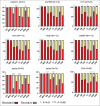High Prevalence of Antimicrobial Resistance Genes in Multidrug-Resistant Extended-Spectrum Beta-Lactamase-Producing Escherichia coli Clinical Isolates after COVID-19 Pandemic, North Iran
- PMID: 39717239
- PMCID: PMC11665164
- DOI: 10.4103/abr.abr_341_24
High Prevalence of Antimicrobial Resistance Genes in Multidrug-Resistant Extended-Spectrum Beta-Lactamase-Producing Escherichia coli Clinical Isolates after COVID-19 Pandemic, North Iran
Abstract
Background: Amid the COVID-19 pandemic, the surge in hospital admissions and widespread use of broad-spectrum antibiotics have heightened the risk of hospital-acquired infections from multidrug-resistant (MDR) organisms, particularly Escherichia coli. It is imperative to implement stringent measures to curb the spread of antimicrobial resistance in hospitals and devise robust treatment strategies for patients grappling with such infections. To confront this challenge, a comprehensive study was undertaken to examine MDR extended-spectrum beta-lactamase (MDR-ESBL)-producing Escherichia coli isolates from patients with nosocomial infections following the COVID-19 pandemic in Northern Iran.
Materials and methods: The current study was conducted as a cross-sectional study. A total of 12,834 samples were collected from patients with healthcare-associated infections at four designated corona centers in Northern Iran, following the COVID-19 pandemic. Antimicrobial resistance was determined using standard broth micro-dilution, while resistance genes were accurately detected using the multiplex PCR method.
Results: The results indicated that meropenem and ciprofloxacin had a resistance rate of 100% and 98.2%, respectively, while piperacillin-tazobactam showed the highest sensitivity rate at 54.4%. The frequency of specific genes, including bla IMP , bla TEM , AcrA, AcrB, bla CTX , bla OXA-58 , aaclb, bla SHV, and aacla, were found to be 100%, 100%, 99.1%, 99.1%, 91.2%, 80.7%, 64.9%, 44.7%, and 37.7%, respectively.
Conclusions: In the current study, over 50% of MDR-ESBL-producing Escherichia coli isolates exhibited resistance to antibiotics. A combination of antibiotics, including piperacillin-tazobactam and colistin, is recommended for treating extensively drug-resistant Escherichia coli infections.
Keywords: COVID-19; Escherichia coli; extended-spectrum beta-lactamase (ESBL); multidrug-resistant; multiplex polymerase chain reaction.
Copyright: © 2024 Advanced Biomedical Research.
Conflict of interest statement
There are no conflicts of interest.
Figures
Similar articles
-
High prevalence of antimicrobial resistance genes in multidrug-resistant-ESBLs-producing Klebsiella pneumoniae post-COVID-19 pandemic.Iran J Microbiol. 2024 Dec;16(6):745-754. doi: 10.18502/ijm.v16i6.17247. Iran J Microbiol. 2024. PMID: 39737355 Free PMC article.
-
Molecular characteristics and antibiotic resistance profiles of Escherichia coli strains isolated from urinary tract infections in children admitted to children's referral hospital of Qom, Iran.Ann Ig. 2019 May-Jun;31(3):252-262. doi: 10.7416/ai.2019.2288. Ann Ig. 2019. PMID: 31069370
-
Prevalence of Cefotaxime-Resistant Escherichia coli Isolates from Healthy Cattle and Sheep in Northern Spain: Phenotypic and Genome-Based Characterization of Antimicrobial Susceptibility.Appl Environ Microbiol. 2020 Jul 20;86(15):e00742-20. doi: 10.1128/AEM.00742-20. Print 2020 Jul 20. Appl Environ Microbiol. 2020. PMID: 32471914 Free PMC article.
-
[Investigation of beta-lactamase genes and clonal relationship among the extended-spectrum beta-lactamase producing nosocomial Escherichia coli isolates].Mikrobiyol Bul. 2015 Jan;49(1):15-25. doi: 10.5578/mb.8437. Mikrobiyol Bul. 2015. PMID: 25706727 Turkish.
-
Prevalence and genetic characterization of clinically relevant extended-spectrum β-lactamase-producing Enterobacterales in the Gulf Cooperation Council countries.Front Antibiot. 2023 Jun 26;2:1177954. doi: 10.3389/frabi.2023.1177954. eCollection 2023. Front Antibiot. 2023. PMID: 39816644 Free PMC article. Review.
References
-
- World Health Organization Global priority list of antibiotic-resistant bacteria to guide research, discovery, and development of new antibiotics. Available from: https://www.who.int/news/item/27-02-2017-who-publishes-list-of-bacteria-... . [Last accessed on 2023 Oct 30]
LinkOut - more resources
Full Text Sources

